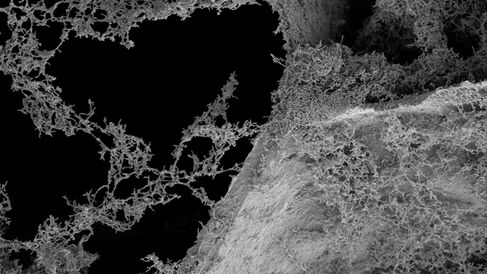
The Howe Group, and collaborators at the Cambridge Graphene Centre, have published an article in the Royal Society of Chemistry's Journal of Materials Chemistry A.
With the world's ever increasing population and economic development straining our energy and clean water supplies, there is a pressing need for novel renewable energy resources and sustainable waste treatment methods. A solution to both of these needs may be found through Microbial Fuel Cells (MFCs). Here, microorganisms metabolise organic substances found in wastewater, in the process donating electrons to an external electrode, generating an electrical output.
Although functional MFCs have previously been produced, their power output has been limited by the rate at which electrons can be transferred from microorganisms to the electrode. In addition, the use of expensive rare metals within electrodes, such as platinum, has reduced their applications and scalability.1-5
Due to its electrical conductivity, cost-effective mass production, biocompatibility, strength and substantial surface area, amongst many other favourable properties, graphene is now a front-runner in current electronics and energy research.6-12 As such, graphene oxide has recently been used to create graphene-based MFC electrodes.13-15 Unfortunately, however, the oxidation process for production of graphene oxide impairs its mechanical and electrical properties, and is continuing to limit MFC capabilities.
In their paper, Call et al. investigate the use of pristine (unmodified) graphene in MFC electrodes for electrical energy production from the bacterium Rhodopseudomonas palustris CGA009, finding an increased rate of electron transfer from the bacteria to the electrode, and consequently an enhanced power output, compared with standard platinum electrodes. In experiments, pristine graphene-based MFCs could successfully run a digital clock, demonstrating their ability to power small electronic devices such as wearable tech or biosensors. Although currently at the proof-of-concept stage, these results highlight the viability of pristine graphene-based electrodes as a cost-effective and environmentally-friendly alternative to platinum electrodes, and have widened the potential applications of MFCs – ranging from power supplies for implanted medical devices to their incorporation into wastewater treatment plants.
1Yu et al., Materials9:807 (2016).
2Wang et al., PLoS One8:1 (2013).
3Wang et al., Nanoscale5:10283 (2013).
4Torres et al., FEMS Microbiol. Rev.34:3 (2010).
5Yuan and He, Nanoscale7:7022 (2015).
6Wachter et al., Nat. Commun.8:14948 (2017).
7Raccichini et al., Nat. Mater.14:271 (2014).
8Stoller et al., Nano Lett.8:3498 (2008).
9Paton et al., Nat. Mater.13:624 (2014).
10Wang et al., Science342:614 (2013).
11Lee et al., Science 321:385 (2008).
12Fabbro et al., ACS Nano. 10:615 (2016).
13Zhang et al., J. Power Sources196:5402 (2011).
14Liu et al., Bioresour. Technol.114:275 (2012).
15Yang et al., Adv. Sci.8:1600097 (2016).
